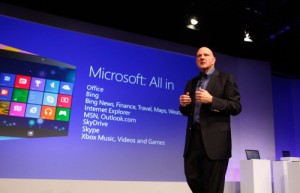Windows 8's enterprise play: evolution not revolution

It often takes businesses several years to roll out a new version of Microsoft Windows, especially if they have a lot of in-house applications to test. With a large section of the market still moving from XP to Windows 7, there are relatively few prospects for enterprise-wide Windows 8 projects. None the less, Erwin Visser, Microsoft's senior director for Windows Commercial, reckons that "customers can start bringing in Windows 8 alongside Windows 7", and he gave some examples of how that could work.

Traditionally, businesses have preferred to have all their users on the same version of Windows, to reduce support costs. It's not clear whether this still makes sense when BYOD (Bring Your Own Device) strategies are introducing dozens of incompatible systems. However, Microsoft's basic argument is that Windows 8 is just the same as Windows 7 from the business software point of view. There is no need to retest software for Windows 8 if it has already been tested in Windows 7 for compatibility, security and compliance.
This glosses over the introduction of Internet Explorer 10, though this may not be a significant problem. In fact, IE10 could have the advantage in being closer to Google Chrome and Firefox in terms of support for modern standards. It's not the same sort of problem as moving from IE6 to a later version.
Windows 8 also includes the touch-oriented TIFKAM (The Interface Formerly Known As Metro) front end, which is strikingly different from anything in Windows 7. This will almost certainly involve some retraining, at least until most users become familiar with Windows 8 on their home PCs.
However, rather than increasing costs, Visser reckons Windows 8 will save money by bringing down "the management costs of mobile devices". It's a roundabout way of claiming that Windows 8 tablets will work with the current enterprise IT infrastructure, while Apple iPads don't.
At a Microsoft seminar in central London this week, three businesses from Microsoft's First Wave adoption programme explained how they were using Windows 8. Their representatives were Peter Scott from British Telecom, Edwin MacGillavry from the Dutch Public Prosecution Service, and Vincent Santacroce from Poste Italiane.
Santacroce said Poste Italiane was developing Windows 8 apps (essentially, CRM) to make its sales reps more efficient. Also, he said, "they feel more cool", which is an advantage because postal authorities tend to be viewed as staid organisations. However, while Poste Italiane was gradually increasing its Windows 8 installations from 60 to this year's target of 500 PCs, it's still in the process of upgrading 95,000 PCs from Windows XP to Windows 7.
Poste Italiane had also implemented an even cooler idea: Poste Shop Kinect. This is a pavement-facing screen in one of its shop windows, using a PC with Microsoft Kinect. Passers-by can search the company's online catalogue even while the shops are closed.
BT's amusingly blunt Peter Scott, who had recently given a similar presentation at a Gartner Symposium in Orlando, said that BT had now equipped 4,500 field engineers with Windows 8 running on Panasonic convertible laptops to replaced old and slow Panasonic ToughBooks running Windows XP. "This was their decision, not ours," said Scott. The advantages included the ability to use the TPM chip in the laptops as a "virtual smartcard" to save log-in times, and the ability to run the engineers' existing Windows software.
BT had also converted some of its apps to run in Metro, and staff could download those and other apps from Microsoft's store. Apps could be "developed quickly at low cost," and since Metro apps are sandboxed and can be removed without trace, there was "a lot less to worry about", said Scott. The main change to BT's IT infrastructure was upgrading Windows Server.
BT's move to Windows 8 is a natural part of its four-year refresh cycle. The company offers a "self service retrofit" service where users can rebuild their own PCs, said Scott. So far, 11,000 users have done that.
"We move to the latest stuff, and it washes over the rest of the company over time."
Scott said the combination of Windows 8, Microsoft Office and Lync 2013 provided "a really rich environment that is extremely challenging and in many cases impossible [to provide] on other devices. And expensive."
Although all three spokesmen were enthusiastic about Windows 8 — which you'd expect in a Microsoft seminar — they were all exploring Windows 8 on Intel. None of them had plans to invest in ARM-powered Windows machines like Surface RT, which Visser described as "a companion device, rather than a full device."
In sum, Windows 8 will attract some enterprise users, but any adoption will probably come through a gradual process of evolution, rather than a revolution. For Microsoft, moving the laggards from XP to Windows 7 is still Job 1.